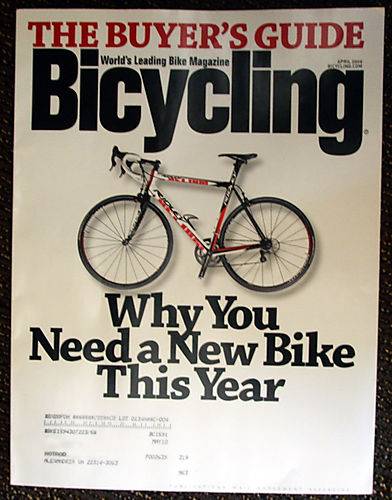 Over a lifetime of cycling, I find my interest either to be either passionate or wanting. Every time I was passionate, I would either pick up a copy or get a subscription to Bicycling Magazine (published by Rodale) to fuel the desire.
Over a lifetime of cycling, I find my interest either to be either passionate or wanting. Every time I was passionate, I would either pick up a copy or get a subscription to Bicycling Magazine (published by Rodale) to fuel the desire.
It was never a great magazine, but it usually would have something of value. It always seemed to have something for someone: a jack of all trades and master of none. It wasn’t perfect for everyone — or maybe anyone — but it would have something for the racers, commuters, touring, etc. type of cyclist, and best of all, it was and is typically universally available. I have been browsing some older copies I kept over the years and, in the past, it would have good do-it-yourself repair information, cycling information and in general, you came away with wanting to ride your bike. These days, I can’t tell where the ad ends and the magazine content begins.
For those that know me, I do lust after the high dollar bikes and my theory is that you cannot have too many gears or bikes, even in flat Champaign-Urbana. In the end, I am also pretty cheap, so my pursuit doesn’t get much further than window shopping. The current April edition’s cover reads, “Why you need to buy a new bike this year.” The main editorial states that having a bike is not a luxury. I can agree with that sentiment, however, the rest of the magazine is devoted to high-dollar bikes that most folks can’t afford. A $10,000 race bike may be fine for some, but most of us don’t need that level of performance, even if we are racing. Put it this way: if you are like me, the key element is not shaving a few ounces from the bike, but rather pounds from the rider.
Even though Bicycling mentions the current economic troubles, they tend to try to get you to believe that you need to commute on a $2,000 bike. The average cost of the bikes featured in the magazine, not including the kids’ bikes, is $3,179. These days, I would not trust parking a $3,179 bikes in a bike rack even in C-U. I may want a $3,000 bike, but I know I don’t need it, and in many cases, I couldn’t use it much either. I understand inflation and that this is not 1989 – or even 1999 – but I don’t see too many people going out and dropping several grand on a bike. Thomas R. Marshall, former Vice President of the United States (1913-21), once eloquently stated that “what this country needs is a good five-cent cigar.” I think that the modern sentiment would be: What this country needs is a good $350 bicycle.
They realize – and even attempt to cover-up – the sticker shock of their buyer’s guide by including an article by Joe Lindsey justifying all of this saying that bikes are actually cheaper than seven years ago, adjusted for inflation. That is, what you get for $5,000 these days is stocked with more technology and features. That may be so if you are looking for a top-of-the-line Specialized. But how many of us could afford a $4,000 bike in 2002, and how many of us can afford a $5,000 bike in 2009? Caviar also may be cheaper now, but that doesn’t mean that we can afford it in either era. Lindsey justification for spending the $5K on a bike is that you don’t want to get dropped by the guy with the new high dollar bike. I don’t worry about the guy riding his second mortgage beating me up a hill; rather, I am worried about the old guy with the 30-year-old Miyata overtaking me. Lindsey goes on to encourage people to ridicule folks who are on older bikes. This is the same old roadie-centric thinking that has prevented cyclists from being united in the past. Now is not the time to fragment our cycling population as we try to have more folks riding and pass laws to protect the commuter, the racer and the urban hipster alike.
But what options are there for cycling reading pleasure besides Bicycling Magazine? Fortunately, there are plenty of free options on the web. Just do a search and you will find many places to satisfy your bicycling reading need. Other magazines also have embraced a much more utilitarian view of cycling: Bicycle Times, Momentum, VeloNews, Urban Velo, etc., have a much more realistic approach.
At this point in Bicycling Magazine’s development, I wouldn’t suggest buying it. However, if you must get every ounce of bicycling material, I suggest heading to the library or even to the Bike Project to look at an issue.
In the future, I intend to bring more information on how to cycle on the cheap … from books and magazines to gear and other fun cycling tidbits.








